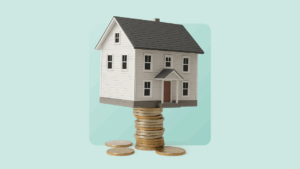3 percent down mortgages: A guide to your options




Key takeaways
- Three percent down mortgages are exactly what they sound like — they require only a 3 percent down payment.
- The lower down payment can make it easier to afford a home, but it will mean higher mortgage payments.
- These mortgages are often part of a program, and borrowers must meet specific program requirements to qualify.
Contrary to traditional wisdom, you don’t necessarily need to save up a full 20 percent down payment in order to buy a home. Some loan programs require only 3 percent of the purchase price to be put down upfront. Here’s what you need to know about 3 percent down mortgages and how they can get you into a home sooner.
3 percent down mortgage options
Mortgages that require a minimum 3 percent down payment are often part of a special program, which means they’re open only to those who meet the program requirements. You must meet the program’s income limits to qualify, and often, you must also be a first-time homebuyer. Here are a few common varieties:
Conventional 97
Backed by Fannie Mae, the Conventional 97 mortgage program allows you to put just 3 percent down and finance 97 percent of the home with a conventional mortgage. It’s sometimes referred to as a 97 Percent LTV loan, for its loan-to-value ratio.
The down payment doesn’t have to come from your savings — the funds can be a gift from a friend or relative, a grant or another form of assistance. However, borrowers must meet certain qualifications to obtain this mortgage, including:
- First-time homebuyer: At least one of the loan applicants must be a first-time homebuyer, or not have owned a home in the past three years.
- Homeownership education course: If all the occupying homebuyers are first-time buyers, at least one applicant must complete a homebuyer education course.
- DTI ratio and credit score requirements: You must meet conventional debt-to-income requirements and have a credit score of 620 or higher.
- Residential requirements: The home you’re buying must be your primary residence, meaning you intend to live in it.
- Conforming loan limitations: The purchase price of the home cannot exceed current conforming loan limits. For 2025, the limit is $806,500 for a one-unit property in most parts of the country; in more expensive areas, the loan limit is $1,209,750.
- Private mortgage insurance: Because you’re putting less than 20 percent down on the home, however, you’ll also need to pay private mortgage insurance (PMI) with your monthly mortgage payment. Your premium will be based on your LTV ratio (in this case, 97 percent) and credit score.
Don’t be put off by this list: “The underwriting guidelines are no more stringent than for any other conventional 30-year mortgage,” says Dan Green, president of Cincinnati-based mortgage company Homebuyer.com.
Conventional 97 mortgages are offered by a variety of lenders, including banks, credit unions and online lenders. Mortgage brokers may have a line on them too.
HomeReady
Also backed by Fannie Mae, the HomeReady program lets you use financing to buy a more varied array of properties, including a single-family home, a condo or a residential multi-family building (provided you live in one of the units). You do not need to be a first-time buyer to qualify. The eligibility requirements for HomeReady include:
- Income limits: Applicant income cannot exceed 80 percent of the area’s median income.
- Credit score: Applicants must have a minimum credit score of 620.
- Homeownership education course: Applicants who are first-time buyers must take a homeowner education course.
- Residential requirements: Borrowers can purchase a residential building with up to four units, but at least one unit must be the owner’s primary residence.
- Private mortgage insurance: You must pay PMI premiums.
The HomeReady program also includes more flexible underwriting requirements that allow you to count potential rental income toward your income requirements. In addition, while a 3 percent down payment is standard, 100 percent of your contribution can come from money received as gifts and down payment assistance.
Similar to the Conventional 97 program, HomeReady mortgages are offered by a variety of private lenders (you do not apply directly to Fannie Mae). You can find lenders offering this mortgage with a simple internet search.
Home Possible
Freddie Mac’s Home Possible program has similar terms to Fannie Mae’s HomeReady program. One big distinction: It allows non-occupying co-borrowers to contribute funds to the 3 percent down payment for one-unit properties. Some of the requirements for Home Possible include:
- Income limits: Applicant income cannot exceed 80 percent of the area’s median income.
- Credit score: Applicants must have a minimum credit score of 660.
- Homeownership education course: Applicants who are first-time buyers must take a homeowner education course.
- Residential requirements: The home must be your primary residence.
- Private mortgage insurance: You must pay PMI premiums.
Note that, while both HomeReady and Home Possible programs are designed to help lower-income buyers, Home Possible requires a higher credit score of at least 660 (HomeReady’s minimum is just 620).
Home Possible mortgages are not available directly from Freddie Mac. The income limits mean these loans are not as widely available as some other mortgage programs: You’ll need to shop around to find lenders who participate in this program.
HomeOne
Freddie Mac also backs the HomeOne program. These mortgages are designed for applicants who have limited down payment funds and homeowners who are interested in a cash-out refinance. Requirements to obtain a HomeOne mortgage include:
- First-time homebuyer: At least one of the applicants must be a first-timer, who has never owned a home before or hasn’t for at least the last three years.
- Credit score: At least one applicant must have what Freddie Mac deems a usable credit score — meaning a score that’s based on enough history to determine that the individual has a track record of being a responsible borrower, or an “acceptable credit reputation,” as their guidelines put it.
- Homeownership education course: If all borrowers involved in the purchase are first-time buyers, a homebuyer education course is required.
- Residential requirements: All borrowers must occupy the home as their primary residence.
- Eligible homes: HomeOne can only be used to purchase single-unit properties, which can include townhouses or condos. It cannot be used to buy manufactured homes.
- Private mortgage insurance: You must pay PMI premiums.
Unlike other 3 percent down mortgage programs, there are no income limits associated with the HomeOne loan. There are no geographic or location limitations for this program either.
Similar to the other mortgage programs, HomeOne is not available directly from Freddie Mac. Instead, you’ll need to research and find a private lender offering it (typically one that participates in Freddie Mac programs).
Other low-down payment options
Beyond the Fannie Mae and Freddie Mac programs featured above, there are other mortgage types that offer low down payment options. These include:
- FHA loans: Insured by the Federal Housing Administration, FHA loans allow borrowers to put down just 3.5 percent with a credit score of 580 or higher, or at least 10 percent with a score as low as 500. However, FHA borrowers with less than 20 percent down must pay FHA mortgage insurance premiums (MIP) for the life of the loan — in most cases, it can’t be removed when you hit a particular equity level like conventional PMI can. “The FHA is a catch-all, serving homebuyers who are not eligible for the other programs,” says Green. “It’s purposefully inclusive and tries to support as many homeowners as possible. You don’t need to be low- or moderate-income to qualify.”
- USDA and VA loans: Technically, USDA and VA loans don’t require any down payment at all. But they’re only for very specific types of borrowers: USDA loans are for borrowers buying in certain approved rural areas, and VA loans are exclusively for active-duty military service members, veterans and surviving spouses. Neither charge mortgage insurance, but USDA loans come with guarantee fees and VA loans come with a funding fee.
Pros and cons of a 3 percent down mortgage
While a 3 percent down mortgage can make homeownership more accessible, it carries a few drawbacks. Here are some pros and cons to consider:
Pros
- Increased affordability: The biggest pro is that the smaller down payment makes it easier to afford a home purchase. In a market with rising home prices, this can make all the difference between homeownership and staying on the sidelines.
- Savings: The money you save with a lower upfront payment means that you have more money to put toward other costs, like moving expenses or home updates. Those savings can also go toward other financial goals, like paying off high-interest debt or building an emergency fund.
Cons
- PMI required: When you make a down payment of less than 20 percent, you’ll have to pay PMI until you reach that equity threshold, which increases your monthly mortgage payments.
- Less equity: With a smaller down payment, you’ll start with less equity in the home. This runs the risk of your mortgage going underwater if home values drop.
- Higher debt load: Making a smaller down payment means borrowing more, which leaves you with a bigger debt to repay. Your monthly mortgage payments will be higher, and you’ll pay more interest over the loan’s term.
FAQs
Why we ask for feedback Your feedback helps us improve our content and services. It takes less than a minute to complete.
Your responses are anonymous and will only be used for improving our website.




